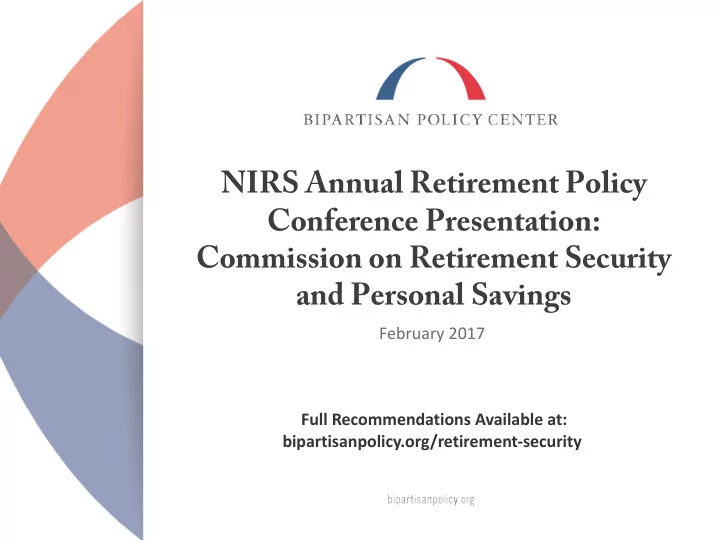

NIRS Annual Retirement Policy Conference Presentation: Commission on Retirement Security and Personal Savings February 2017 Full Recommendations Available at: bipartisanpolicy.org/retirement-security
SIX MAJOR RECOMMENDATIONS FOR RETIREMENT SECURITY AND PERSONAL SAVINGS Improve Access to Workplace Retirement Savings Plans • Promote Personal Savings for Short-Term Needs and Preserve • Retirement Savings for Older Age Facilitate Lifetime-Income Options to Make Savings Last in • Retirement Facilitate the Use of Home Equity for Retirement Consumption • Improve Financial Capability Among All Americans • Strengthen Social Security’s Finances and Modernize the • Program 2
COMMISSION’S PROPOSALS SIGNIFICANTLY DECREASE ELDERLY POVERTY 3
IMPROVE ACCESS TO WORKPLACE RETIREMENT SAVINGS PLANS Today: Less than half of private-sector workers participate in a retirement savings plan Don't Have Have Access and Access Contribute 34% 49% Have Access but Don't Contribute 17% 4
AUTOMATIC ENROLLMENT INCREASES PARTICIPATION Participation Rates by Plan Design and Income Voluntary Automatic Income Enrollment Enrollment <$30,000 32% 83% $30,000-$49,999 55% 89% $50,000-$74,999 62% 92% $75,000-$99,999 69% 95% $100,000 + 85% 97% BPC’s Recommendations would increase access to retirement savings plans for tens of millions of Americans who lack access today; auto-enrollment through payroll deduction and other provisions would help them maintain and grow these savings; and recommendations on reverse mortgages, lifetime income would help to ensure it lasts, paving the way to a more secure retirement. 5
MINIMUM-COVERAGE STANDARD INCREASES MIDDLE- CLASS SAVINGS BY ROUGHLY 50 PERCENT Change in Savings for Individuals Aged 62 and Older (2065) 60% Percentage Difference in Retirement Savings 50% 40% 30% 20% 10% 0% Bottom Earning 2nd Quintile Middle Quintile 4th Quintile Top Earning Quintile Quintile Position in the Lifetime-Earnings Distribution Note: Retirement savings include savings in defined contribution plans, such as 401(k) plans, IRAs, and Keogh plans, which are available to self- employed individuals. Population is segmented based on lifetime earnings. Figure is presented on a per-capita basis. Source: The Urban Institute -- DYNASIM3 6
COMMISSION RECOMMENDATIONS MAKE SOCIAL SECURITY SOLVENT FOR 75 YEARS AND BEYOND 7% 6.42% 6% 5.59% 5.23% 5% 4.66% Percentage of GDP 4% 3% Scheduled Benefits Commission Package Benefits 2% Current Revenues Commission Package Revenues 1% Payable Benefits 0% 2005 2015 2025 2035 2045 2055 2065 2075 2085 Year Note: The scheduled-benefits scenario assumes that benefits are paid out of the general treasury according to the existing benefit formula despite insufficient Social Security revenues. The payable-benefits scenario assumes that benefits are limited to levels that can be financed with existing, dedicated Social Security revenues after the exhaustion of the trust funds. 7 Source: The Urban Institute -- DYNASIM3
SOCIAL SECURITY MODERNIZATION REDUCES OLD- AGE POVERTY RATE BY ONE-THIRD OVER 20 YEARS 12% 10% 8% Poverty Rate 6% 4% 2% 0% 2015 2035 2065 Scheduled (Underfinanced) Benefits Scenario Payable (Fully Financed) Benefits Scenario Commission Package (Fully Financed) Note: The scheduled-benefits scenario assumes that benefits are paid out of the general treasury according to the existing benefit formula despite insufficient Social Security revenues. The payable-benefits scenario assumes that benefits are limited to levels that can be financed with existing, dedicated Social Security revenues after the exhaustion of the trust funds. 8 Source: The Urban Institute -- DYNASIM3
MINIMUM-COVERAGE STANDARD AND SOCIAL SECURITY PROPOSALS HELP MIDDLE- AND LOWER- EARNERS Disposable Income for Americans Aged 62 and Older (2065) $100,000 $90,000 Average Disposable Income $80,000 $70,000 $60,000 $50,000 $40,000 $30,000 $20,000 $10,000 $0 Bottom Earning 2nd Quintile Middle Quintile 4th Quintile Top Earning Quintile Quintile Position in the Lifetime-Earnings Distribution Payable-Benefits Scenario (Payable with Existing Revenues) Commission Package (Fully Financed) Scheduled-Benefits Scenario (Not Payable with Existing Revenues) Note: Disposable income includes cash income from all sources, such as Social Security benefits and retirement account withdrawals, after subtracting taxes and Medicare premiums. Disposable income does not include cash equivalents from in-kind benefit programs, such as SNAP. Population is segmented based on lifetime earnings. Figure is presented on a per-capita basis. 9 Source: The Urban Institute -- DYNASIM3
Recommend
More recommend